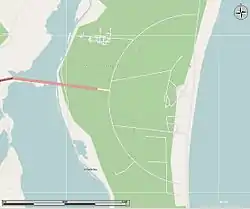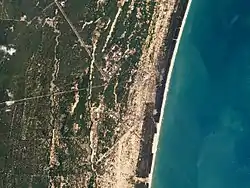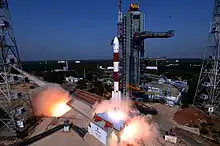Satish Dhawan Space Centre
Satish Dhawan Space Centre (SDSC) or Sriharikota Range (SHAR)[1] is a rocket launch centre (spaceport) operated by Indian Space Research Organisation (ISRO). It is located in Sriharikota in Andhra Pradesh. Sriharikota Range was renamed in 2002 after ISRO's former chairman Satish Dhawan.
 Map of SDSC | |
 Satellite imagery of SDSC two days before PSLV-C37 launch. | |
| Abbreviation | SDSC |
|---|---|
| Named after | Satish Dhawan |
| Formation | 1 October 1971 |
| Location |
|
| Coordinates | 13°43′11.78″N 80°13′49.53″E |
Director | Arumugam Rajarajan |
Parent organisation | ISRO |
| Website | www |
Formerly called | Sriharikota Range (SHAR) |
History
Sriharikota island was chosen in 1969 for a satellite launching station. The centre became operational in 1971 when an RH-125 sounding rocket was launched.[2] The first attempted launch of an orbital satellite, Rohini 1A aboard a Satellite Launch Vehicle, took place on 10 August 1979, but due to a failure in thrust vectoring of the rocket's second stage, the satellite's orbit decayed on 19 August 1979.[3] SHAR was named as 'Satish Dhawan Space Centre SHAR' (SDSC), on 5 September 2002, in memory of Satish Dhawan, former Chairman of the ISRO.
The SHAR facility now consists of two launch pads, with the second built in 2005. The second launch pad was used for launches beginning in 2005 and is a universal launch pad, accommodating all of the launch vehicles used by ISRO. The two launch pads will allow multiple launches in a single year, which was not possible earlier. India's lunar orbiter Chandrayaan-1 launched from the centre at 6:22 AM IST on 22 October 2008. India's first Mars orbiter Mangalyaan was launched from the centre on 5 November 2013, which was successfully placed into Mars orbit on 24 September 2014.
Initially under Indian Human Spaceflight Programme existing launch facilities will be augmented to meet the target of launching a crewed spacecraft called Gaganyaan.[4]
SDSC's current director is Arumugam Rajarajan.[5][6] He took over from S. Pandian in July 2019.
Location
Satish Dhawan Space Centre (SHAR) is located in Sriharikota, a spindle-shaped barrier island on the east coast of Andhra Pradesh. Features like a good launch azimuth corridor for various missions, nearness to the equator (benefiting eastward launches), and large uninhabited area for a safety zone make it an ideal spaceport.
SHAR covers a total area of about 145 km2 (56 sq mi) with a coastal length of 27 km (17 mi). Prior to its acquisition for ISRO by the Government of India, it was a firewood plantation of Eucalyptus and Casuarina trees. This island is affected by both south-westerly and north-easterly monsoons, but heavy rains come only in October and November. Thus many clear days are available for out-door static tests and launchings.[7]
SHAR is linked to Sullurupeta by a road across Pulicat Lake. Sullurupeta has connectivity with other parts of India by Indian Railways and is on a National Highway 5 (India) that connects it to Chennai (about 83 km (52 mi) south) and Kolkata.
Launch history
Originally known as the Sriharikota Range (SHAR)[1] and later named after Satish Dhawan. It is India's primary orbital launch site to this day. First flight-test of 'Rohini-125', a small sounding rocket which took place on 9 October 1971 was the first rocket launch from SHAR.[8] Since then technical, logistic and administrative infrastructure have been enhanced. Together with the northerly Balasore Rocket Launching Station, the facilities are operated under the ISRO Range Complex (IREX) headquartered at SHAR.[9]
Satellite Launch Vehicle (SLV)
The range became operational when three Rohini 125 sounding rockets were launched on 9 and 10 October 1971. Previously, India used Thumba Equatorial Rocket Launching Station (TERLS), at Thiruvananthapuram, on the south-western coast of India, to launch sounding rockets. The first test launch of the complete SLV-3 rocket occurred in August 1979 but it was only partially successful following a malfunction in the second-stage guidance system. SHAR facilities worked satisfactorily during the SLV-3 preparation and launch. On 18 July 1980 the SLV-3 successfully launched India's third satellite. Out of the four SLV launches from SHAR, two were successful.
Augmented Satellite Launch Vehicle (ASLV)
The ASLV orbital launcher was integrated vertically, beginning with motor and subassembly preparations in the Vehicle Integration Building (VIB) and completed on the pad within the 40 m tall Mobile Service Structure. The first ASLV launch from SHAR took place in 1987 and resulted in a failure. Eventually, out the four ASLV launches from 1987–94, only one was successful.
Polar Satellite Launch Vehicle (PSLV)
The PSLV launch complex was commissioned during 1990. It has a 3,000 tonne, 76.5 m high Mobile Service Tower (MST) which provides the SP-3 payload clean room. The solid propellant motors for the PSLV are processed by SHAR, which also carries out launch operations. The first launch of the PSLV took place on 20 September 1993.[10]
Facilities
The SDSC has two operational orbital launch pads. SHAR is ISRO's satellite launching base and additionally provides launch facilities for the full range of Rohini sounding rockets. The Vehicle Assembly, Static Test and Evaluation Complex (VAST, previously STEX) and the Solid Propellant Space Booster Plant (SPROB) are located at SHAR for casting and testing solid motors. The site also has a Telemetry, Tracking, Range Instrumentation, & Control centre for Range Operation (RO), Liquid Propellant Storage and Servicing Facilities (LSSF), the Management Service Group and Sriharikota Common Facilities. The PSLV launch complex was commissioned in 1990. It has a 3,000 tonne, 76.5 m high Mobile Service Tower (MST) which provides the SP-3 payload clean room.[11]
The Solid Propellant Space Booster Plant (SPROB) processes large size propellant grains for the satellite launch vehicles. The Vehicle Assembly & Launching Facility (VALF), Solid Motor Preparation & Environmental Testing Facility (SMP&ETF) tests and qualifies different types of solid motor for launch vehicles. The control centre at SHAR houses computers and data processing, closed circuit television, real-time tracking systems and meteorological observation equipment. It is linked to eight radars located at Sriharikota and the five stations of ISRO's Telemetry, Tracking & Command Network (ISTRAC).
The propellant production plant produces composite solid propellant for rocket motors of ISRO using ammonium perchlorate (oxidiser), fine aluminium powder (fuel) and hydroxyl terminated polybutadiene (binder). The solid motors processed here include those for the first-stage booster motor of the Polar Satellite Launch Vehicle (PSLV) — a five segmented motor of 2.8 m (9 ft 2 in) diameter and 22 m (72 ft) length, weighing 160 tonnes (160 long tons; 180 short tons) with a thrust level of 450 tonnes (440 long tons; 500 short tons).
Rocket motors and their subsystems have to be rigorously tested and evaluated on ground before they are declared flight worthy. The facilities at SDSC are used for testing solid rocket motors, both at ambient conditions and simulated high altitude conditions. Besides these, there are facilities for conducting vibration, shock, constant acceleration and thermal/humidity tests.
SDSC has infrastructure for launching satellites into low Earth orbit, polar orbit and geo-stationary transfer orbit. The launch complexes provide support for vehicle assembly, fueling, checkout and launch operations. The Centre also has facilities for launching sounding rockets for atmospheric studies. The mobile service tower, launch pad, preparation facilities for different launch stages & spacecraft, storage, transfer and servicing facilities for liquid propellants, etc., are the principal parts of the PSLV/GSLV launch complex.
For supporting the GSLV Mark III, additional facilities were set up at SDSC. A new plant (SPP) is set up to process heavier class boosters with 200 tonnes of Solid propellant. The static test complex is being augmented for qualifying the S-200 booster. Other new facilities include a Solid Stage Assembly Building, Satellite Preparation and Filling Facility and Hardware Storage buildings. The existing liquid propellant and cryogenic propellant storage and filling systems, Propellant Servicing Facilities will also be augmented. The range instrumentation system will be enhanced further.
SDSC also has a S band Doppler weather radar[12] that contributes to India Meteorological Department radar network and serves as a stand-in for Doppler weather radar in Chennai.[13]
ISRO opened a viewing gallery at the Satish Dhawan Space Centre in March 2019. The gallery faces the two launchpads and can accommodate 5,000 people giving the general public the opportunity to witness rocket launches. The launch of PSLV-C45 on 1 April 2019 was the first launch that allowed spectators into the gallery.[14]
Launch pads
 PSLV-C45 liftoff at Second Launch Pad | |||||||||||||||||||||||||||||||||||||
| Operator | ISRO | ||||||||||||||||||||||||||||||||||||
|---|---|---|---|---|---|---|---|---|---|---|---|---|---|---|---|---|---|---|---|---|---|---|---|---|---|---|---|---|---|---|---|---|---|---|---|---|---|
| Total launches | 77 | ||||||||||||||||||||||||||||||||||||
| Launch pad(s) | Three | ||||||||||||||||||||||||||||||||||||
| |||||||||||||||||||||||||||||||||||||

SLV3 Launch Pad
The SLV3 Launch Pad began operation in 1979 and was decommissioned in 1994. It was used by two launch vehicles of the ISRO: the Satellite Launch Vehicle (SLV) and the Augmented Satellite Launch Vehicle (ASLV).[15] Initially it was built for launching SLV-3s but was later also used as an ASLV launch complex.[16] The first launch from this pad occurred on 10 August 1979, and was that of the first experimental flight of SLV-3 carrying the Rohini Technology Payload satellite. The last flight was of ASLV on 4 May 1994 carrying SROSS-C2.[15]
First Launch Pad
The First Launch Pad[17] began operation in 1993. It is currently used by two launch vehicles of the ISRO: the Polar Satellite Launch Vehicle (PSLV) and the Geosynchronous Satellite Launch Vehicle (GSLV). It is one of two operational orbital launch pads at the site, the other being the Second Launch Pad,[18] which opened in 2005. The first launch from this pad occurred on 20 September 1993, and was the maiden flight of the Polar Satellite Launch Vehicle carrying the IRS-1E satellite.
The First Launch Pad is undergoing major expansion with PIF (PSLV Integration Facilities) project worth ₹475 crore (US$67 million) . Once complete, the first launch pad is expected to cater to around 15 launches per year. [19]
Second Launch Pad
The Second Launch Pad was designed, supplied, erected and commissioned by MECON Limited, a Government of Indian Enterprise, located at Ranchi (Jharkhand, India) during the period March 1999 to December 2003.[20] It cost about ₹400 crore (equivalent to ₹11 billion or US$150 million in 2019) at that time.[21] The second launch pad with associated facilities was built in 2005. However it became operational on 5 May 2005 with the launching of PSLV-C6. MECON's sub-contractors for this project including Inox India, HEC, Tata Growth, Goderej Boyce, Simplex, Nagarjuna Construction, Steelage, etc. The other Launch Pad being the First Launch Pad. It is used by Polar Satellite Launch Vehicles, Geosynchronous Satellite Launch Vehicles, GSLV Mark III and is intended for India's first manned space mission.[17][22]
The first launch from the pad occurred on 5 May 2005, and was of a Polar Satellite Launch Vehicle carrying the CARTOSAT-1 and HAMSAT satellites.[23] India's 1st Moon Mission, Chandrayan-I was launched from this launch pad on 22 October 2008. Its follow-up mission Chandrayaan-2 was also launched from this launch pad on 22 July 2019.
In November 2019, ISRO released tenders for augmentation of SLP for Gaganyaan project.[24][25][26][27]
Third Launch Pad
A Third Launch Pad has been proposed in 2012[28] with estimated cost to be ₹5 billion (US$70 million).[29]
This launch pad is intended to be used for future Indian rockets like the Unified Launch Vehicle and GSLV Mark III as well as the older ones like Polar Satellite Launch Vehicle and Geosynchronous Satellite Launch Vehicle.[30] The launch pad will be used for the India's future human space missions.[31] One of the main reasons of building this launch pad is that it will increase the frequency of orbital launches by ISRO.[32]
In 2018, it was reported that the launch of India's first crewed orbital spacecraft "Gaganyaan" is scheduled to be launch from the third launch pad before 2022.[33] However in November 2019, ISRO released tenders for augmentation of Second Launch Pad for Gaganyaan project.[34][35][36][37][38]
See also
- Baikonur Cosmodrome – Rocket launch complex in Kazakhstan, used by Russia
- Kennedy Space Center – United States space launch site
- RLV-TD – Reusable launch vehicle technology demonstrator
References
- Rao, P. V. Manoranjan; B. N. Suresh; V. P. Balagangadharan, eds. (2015). "4.1 The Spaceport of ISRO - K. Narayana". From Fishing Hamlet to Red Planet: India's Space Journey. India: Harper Collins. p. 328. ISBN 9789351776901.
This centre was originally named SHAR (an acronym for Sriharikota Range – mistakenly referred to as Sriharikota High Altitude Range by some people) by Sarabhai. SHAR in Sanskrit also means arrow, symbolic of the nature of activity and that seems to be the significance of the acronym.
- "RH-125". Encyclopedia Astronautica.
- "SLV". Encyclopedia Astronautica.
- "India's human space programme gets a fillip". The New Indian Express. Retrieved 12 August 2019.
- "SDSC-SHAR Website". www.shar.gov.in. Retrieved 12 August 2019.
- "షార్ డైరెక్టర్గా రాజరాజన్ బాధ్యతల స్వీకరణ". Sakshi (in Telugu). 30 June 2019. Retrieved 12 August 2019.
- Archived 6 September 2009 at the Wayback Machine Sriharikota Launching Range-Source Bharatrakshak.com
- "SDSC: Planet Vision". 15 October 2009. Retrieved 5 April 2020.
- "Archived copy". Archived from the original on 7 July 2012. Retrieved 6 August 2010.CS1 maint: archived copy as title (link) Unveiling of the Bust of Satish Dhawan at Satish Dhawan Space Centre, Sriharikota & Presentation of Astronautical Society of India Awards by Prime Minister-Press Release, Date Released: Wednesday, 21 September 2005, Source: Indian Space Research Organisation
- "India (Launchers)". Spacecraft Encyclopedia. Retrieved 2 May 2020.
- Satish Dhawan Space Centre (SDSC), Sriharikota Range (SHAR) (India), Civil space organisations – Launch facilities, Source – Jane's Information Group
- "IMD - Radar Images and Products". www.imd.gov.in. Retrieved 5 September 2018.
- "IMD expanding radar network for improved forecasts". The New Indian Express. Retrieved 5 September 2018.
- "Isro finally opens door for people to watch rocket launches - Times of India". The Times of India. Retrieved 30 March 2019.
- "Sriharikota SLV". Encyclopedia Astronautica. Retrieved 10 November 2013.
- Brian Harvey; Henk H. F. Smid; Théo Pirard (30 January 2011). Emerging Space Powers: The New Space Programs of Asia, the Middle East and South-America. Springer. pp. 247–. ISBN 978-1-4419-0874-2.
- "Launch Facility". Indian Space Research Organisation. Archived from the original on 17 April 2010.
- "ISRO planning big missions this year". New Indian Express. Kerala, India. The New Indian Express. 28 February 2013. Retrieved 6 March 2013.
- "PIF Project". Prajasakti.
- "Archived copy" (PDF). Archived from the original (PDF) on 20 December 2013. Retrieved 3 September 2013.CS1 maint: archived copy as title (link)
- http://www.telegraphindia.com/1081023/jsp/jharkhand/story_10006297.jsp
- "SDSC SHAR/Sr.HPS/PT/RO/11/2019-20". www.isro.gov.in. Indian Space Research Organization. 7 November 2019. Retrieved 22 November 2019.
- Wade, Mark. "Sriharikota SLP". Encyclopedia Astronautica. Retrieved 12 April 2010.
- "RFP TO REALISE HYDRANT SYSTEM FOR AUGMENTED FACILITIES AT SLP COMPLEX (ASLP) SDSC, SHAR SRIHARIKOTA" (PDF). www.isro.gov.in. Indian Space Research Organization. 7 November 2019. Retrieved 22 November 2019.
- "Work Contract to carry out Video and Still Photography documentation coverage and VIDEO Editing Works of Technical Photography Facility" (PDF). www.isro.gov.in. Indian Space Research Organization. 7 November 2019. Retrieved 22 November 2019.
- "SUPPLY OF RAW MATERIAL, FABRICATION, ERECTION AND COMMISSIONING OF STRUCTURAL ELEMENTS FOR GAGANYAAN MISSION AT UMBILICAL TOWER OF SECOND LAUNCH PAD (SLP)" (PDF). www.isro.gov.in. Indian Space Research Organization. 7 November 2019. Retrieved 22 November 2019.
- "REALISATION OF NEW HYDRAULIC SYSTEM FOR CREW ACCESS ARM (CAA) and AUGMENTATION/MODIFICATION OF EXISTING SCVRP-3 HYDRAULIC SYSTEM FOR SERVICING GAGANYAAN MISSION AT UMBILICAL TOWER (UT) OF SECOND LAUNCH PAD (SLP)" (PDF). www.isro.gov.in. Indian Space Research Organization. 7 November 2019. Retrieved 22 November 2019.
- Chandrashekar, Nandini (2 June 2012). "3rd launch pad to be built". Deccan Herald. Bangalore. Retrieved 21 November 2020.
- "High-tech third launch pad in Sriharikota soon". Deccan Herald. 29 March 2015. Retrieved 23 July 2019.
- "Isro to build third launchpad at Sriharikota". PTI. Times of India. 1 July 2012. Retrieved 8 June 2013.
- "ISRO to begin process for Human Space Flight Mission". PTI. Hyderabad. India Today. 26 January 2010. Retrieved 8 June 2013.
- "ISRO To Build A Third Launch Pad at Spaceport". Indiadefence.com. 2 June 2012. Retrieved 8 June 2013.
- Peri, Dinakar (21 September 2018). "ISRO setting up launch pad for Gaganyaan mission". The Hindu. ISSN 0971-751X. Retrieved 22 September 2018.
- "SDSC SHAR/Sr.HPS/PT/RO/11/2019-20". www.isro.gov.in. Indian Space Research Organization. 7 November 2019. Retrieved 22 November 2019.
- "RFP TO REALISE HYDRANT SYSTEM FOR AUGMENTED FACILITIES AT SLP COMPLEX (ASLP) SDSC, SHAR SRIHARIKOTA" (PDF). www.isro.gov.in. Indian Space Research Organization. 7 November 2019. Retrieved 22 November 2019.
- "Work Contract to carry out Video & Still Photography documentation coverage and VIDEO Editing Works of Technical Photography Facility" (PDF). www.isro.gov.in. Indian Space Research Organization. 7 November 2019. Retrieved 22 November 2019.
- "SUPPLY OF RAW MATERIAL, FABRICATION, ERECTION AND COMMISSIONING OF STRUCTURAL ELEMENTS FOR GAGANYAAN MISSION AT UMBILICAL TOWER OF SECOND LAUNCH PAD (SLP)" (PDF). www.isro.gov.in. Indian Space Research Organization. 7 November 2019. Retrieved 22 November 2019.
- "REALISATION OF NEW HYDRAULIC SYSTEM FOR CREW ACCESS ARM (CAA) & AUGMENTATION/MODIFICATION OF EXISTING SCVRP-3 HYDRAULIC SYSTEM FOR SERVICING GAGANYAAN MISSION AT UMBILICAL TOWER (UT) OF SECOND LAUNCH PAD (SLP)" (PDF). www.isro.gov.in. Indian Space Research Organization. 7 November 2019. Retrieved 22 November 2019.
External links
| Wikimedia Commons has media related to Satish Dhawan Space Centre. |
